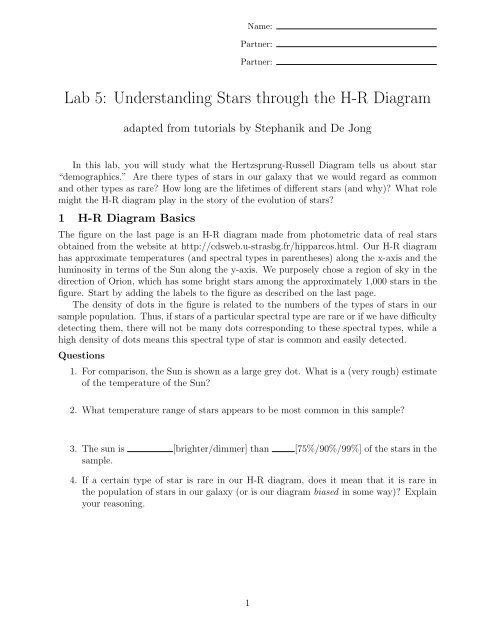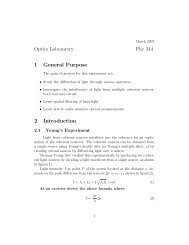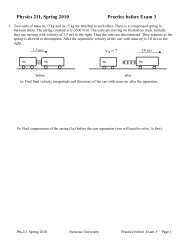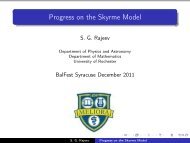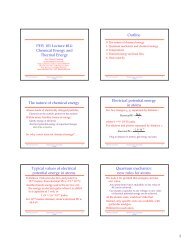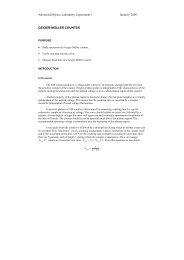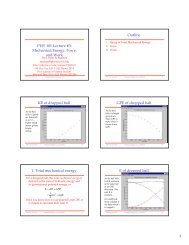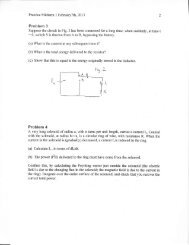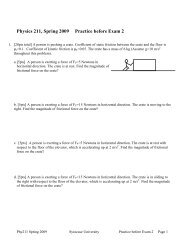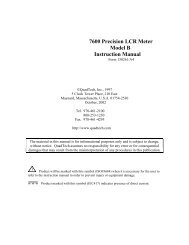Lab 5: Understanding Stars through the H-R Diagram - Physics
Lab 5: Understanding Stars through the H-R Diagram - Physics
Lab 5: Understanding Stars through the H-R Diagram - Physics
You also want an ePaper? Increase the reach of your titles
YUMPU automatically turns print PDFs into web optimized ePapers that Google loves.
of fuel, and you grill often enough to burn 5 lb per month, <strong>the</strong> tank will last for 4 months.For <strong>the</strong> sun, <strong>the</strong> fuel is <strong>the</strong> mass of hydrogen in its core (or more precisely <strong>the</strong> energy Mc 2of <strong>the</strong> mass). The rate it uses <strong>the</strong> fuel is given by <strong>the</strong> sun’s luminosity, L = 4 × 10 26 watts.The mass of <strong>the</strong> sun is M = 2×10 30 kg, and <strong>the</strong> mass in <strong>the</strong> core of <strong>the</strong> sun is about one tenththis total. Also, in <strong>the</strong> proton-proton cycle only about 0.007 of <strong>the</strong> mass of <strong>the</strong> protons isconverted to energy. After all, <strong>the</strong>re are Helium nuclei left over after <strong>the</strong> reaction. Therefore,taking into account both factors, only 0.1 × 0.007 of <strong>the</strong> mass of <strong>the</strong> Sun is converted intoluminous energy. With this in mind, we have a formula for <strong>the</strong> lifetime of <strong>the</strong> Sun.lifetime of Sun = 0.0007 Mc2L .Recall <strong>the</strong> speed of light c = 3 × 10 8 m/s and plug in our data on M and L to getlifetime of Sun = 0.0007 2 × 1030 × (3 × 10 8 ) 2= 7 × 2 × 9 × 10 16 = × seconds.4 × 10 26 4The previous answer is difficult to comprehend in any meaningful manner. Convert it tobillions of years by dividing by <strong>the</strong> number of seconds in a billion years (roughly 3 × 10 16 s).The main sequence lifetime of <strong>the</strong> Sun =3.2 An AnalogyConsider two cars, A and B.billions of years.• Car A is a two-door coupe. It gets 50 miles per gallon and has a 10-gallon tank.• Car B is an SUV. It gets 2 miles per gallon and has a 30-gallon tank.1. Which car holds more fuel?2. Suppose both cars embark on a very long journey toge<strong>the</strong>r, side-by-side, each with afull tank of gas. Which car will run out of fuel first?3. Explain <strong>the</strong> apparent contradiction between your previous two answers.4. Which car would you expect to put out more power? Explain your reasoning.3.3 Lifetimes and Stellar PropertiesAs you know from experience, it is possible for something to hold more fuel but run out ofthat fuel faster. This idea applies directly to stars. Since a star’s lifetime is longer if it has4
more mass (more fuel) but shorter if it has a higher luminosity (uses <strong>the</strong> fuel more quickly)a star’s lifetime is proportional to its mass divided by its luminosity, a quantity known asits mass-to-light ratio. More massive stars get crushed more under <strong>the</strong>ir own weight, leadingto higher temperatures, much faster fusion in <strong>the</strong>ir cores, and much higher power output, orluminosity. Similar to <strong>the</strong> SUV in <strong>the</strong> example, stars that are more massive and have morehydrogen will <strong>the</strong>refore have smaller mass-to-light ratios and always run out of hydrogen fuelin <strong>the</strong>ir cores sooner than those that are less massive. Put ano<strong>the</strong>r way: stars that containmore mass live shorter lives than those containing less mass. The heavier a star, <strong>the</strong> shorter<strong>the</strong> life span.Using <strong>the</strong> concepts given above, answer <strong>the</strong> following questions: Consider two mainsequencestars, Proxima Centauri (<strong>the</strong> closest star to <strong>the</strong> Sun) and Vega (<strong>the</strong> star from <strong>the</strong>movie Contact).• Proxima Centauri has a mass of 0.12 solar masses.• Vega has a mass of 2.6 solar masses1. Which star contains more hydrogen to fuse into helium?2. Which star will put out more power (i.e., use more energy per second and be moreluminous)? Explain your reasoning.3. Which star will run out of hydrogen first and thus leave <strong>the</strong> main sequence first?Generalize your result using <strong>the</strong> H-R diagram to tell you <strong>the</strong> relationship between <strong>the</strong> colorof a main-sequence star, its surface temperature, its luminosity, and its mass-to-light ratio.Fill in <strong>the</strong> blanks in <strong>the</strong> following table so that <strong>the</strong> relationships are expressed clearly.Temperature Luminosity Lifetime Mass-to-light ratioColor (hotter or cooler) (higher or lower) (longer or shorter) (higher or lower)BluerRedderNow let’s look at stellar lifetimes quantitatively. If a star had twice <strong>the</strong> mass of <strong>the</strong> Sunand <strong>the</strong> same luminosity, <strong>the</strong>n it could be expected to last twice as long. On <strong>the</strong> o<strong>the</strong>r hand,if <strong>the</strong> star’s luminosity were four times greater than <strong>the</strong> Sun, it would not last as long. Thelifetime of a star depends directly on its mass-to-light ratio, and is approximately5
number of times more massive than Sunlifetime of star = × 10 billion years (1)number of times more luminous than SunAstronomers have measured <strong>the</strong> masses of a few of <strong>the</strong> main-sequence stars on your H-Rdiagram. The Table below lists <strong>the</strong>se stars’ spectral types and approximate masses, toge<strong>the</strong>rwith <strong>the</strong> mass and luminosity of a very hot, O-type star not on your diagram. Using yourH-R diagram, determine <strong>the</strong> luminosity of each of <strong>the</strong>se stars. Then find <strong>the</strong> lifetimes of <strong>the</strong>stars using equation 1.Spectral Type Mass (M sun ) Luminosity (L sun ) Lifetime (years)O 50 500,000B8 5A 2K 0.5M 0.11. Explain why astronomers are unable to measure <strong>the</strong> masses of all <strong>the</strong> stars that arevisible. In what way does a star have to be special to allow its mass to be determined?2. Based on <strong>the</strong> table of lifetimes, try to figure out and describe reasoning that helpsexplain why O-type stars are so rare (and why <strong>the</strong>re are none on your H-R diagram).3. (extra credit) As you will learn later in <strong>the</strong> course, <strong>the</strong> oldest stars in <strong>the</strong> Galaxy appearto be about 12 billion years old. Based on <strong>the</strong> table of lifetimes, try to figure out anddescribe reasoning that helps explain why white dwarfs are relatively rare even in <strong>the</strong>list of <strong>the</strong> 20 closest stars, despite <strong>the</strong> fact that we think all main-sequence stars fromtype B on down and to <strong>the</strong> right (including <strong>the</strong> sun and every o<strong>the</strong>r main-sequencestar plotted on your HR diagram) become white dwarfs.6


